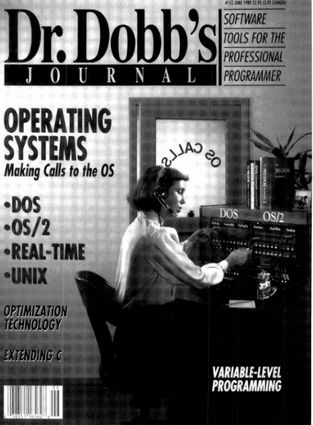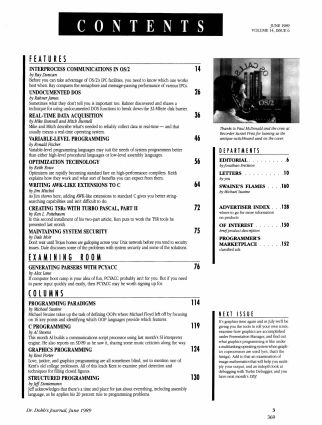
[author : Jonathan Erickson] #Edito
TABLE OF CONTENTS
[author : Ray Duncan]
Before you can take advantage of OS/2’s IPC facilities, you need to know which one works best when. Ray compares the semaphore and message-passing performance of various IPCs.
[author : Rahner James]
Sometimes what they don’t tell you is important too. Rahner discovered and shares a technique for using undocumented DOS functions to break down the 32-Mbyte disk barrier.
[author : Mike Bunnell and Mitch Bunnell]
Mike and Mitch describe what’s needed to reliably collect data in real-time — and that usually means a real-time operating system.
[author : Ronald Fischer]
Variable-level programming languages may suit the needs of system programmers better than either high-level procedural languages or low-level assembly languages.
[author : Keith Rowe]
Optimizers are rapidly becoming standard fare on high-performance compilers. Keith explains how they work and what sort of benefits you can expect from them.
[author : Jim Mischel]
As Jim shows here, adding AWK-like extensions to standard C gives you better string-searching capabilities and isn’t difficult to do.
[author : Ken L. Pottebaum]
In this second installment of his two-part article, Ken puts to work the TSR tools he presented last month.
[author : Dale Moir]
Don’t wait until Trojan horses are galloping across your Unix network before you tend to security issues. Dale discusses some of the problems with system security and some of the solutions.
[author : Alex Lane]
If computer boot camp is your idea of fun, PCYACC probably isn’t for you. But if you need to parse input quickly and easily, then PCYACC may be worth signing up for.
[author : Michael Swaine]
Michael Swaine takes up the task of defining OOPs where Michael Floyd left off by focusing on 16 key points and identifying which OOP languages provide which features.
[author : Al Stevens]
This month Al builds a communications script processor using last month’s SI interpreter engine. He also reports on SD’89 as he saw it, sharing some music criticism along the way.
[author : Kent Porter]
Love, justice, and graphics programming are all sometimes blind, not to mention one of Kent’s old college professors. All of this leads Kent to examine pixel detection and techniques for filling closed figures.
[author : Jeff Duntemann]
Jeff acknowledges that there’s a time and place for just about everything, including assembly language, as he applies his 20 percent rule to programming problems.
[author : you]
[author : Michael Swaine]
where to go for more information on products
brief product description
classified ads
